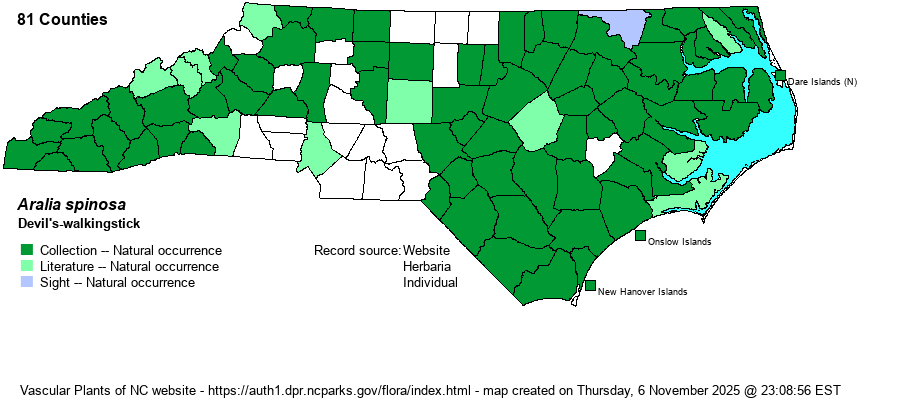| Author | L. | |
| Distribution | Nearly statewide, but with an odd lack of records in a mid-Piedmont strip, for unknown reasons; however, the scarcity there, especially in the southern Piedmont, is certainly real. Note that there are many photographically documented county records based on iNaturalist data, not a surprise, as most people in recent years are more than willing to photograph a tree than to collect a twig (with its spines and overly large leaves).
An Eastern species, ranging from NY and southeastern MO south to central FL and eastern TX.
| |
| Abundance | Generally common in the Coastal Plain; infrequent to fairly common in the eastern Piedmont (but certainly not common) and in the foothills; fairly common in the southern Mountains. For some strange reason, it is quite scarce (uncommon at best) in the central half of the Piedmont, where there seem to be no records for many counties. Rare in the northern Mountains. | |
| Habitat | This is a species mainly of forest borders, often where moist. It is often seen along margins of swamps, pocosins, and bottomlands in the Coastal Plain, but less so inside with deep shade. Farther inland, it is often found in uplands, again mostly along forest borders. It seems to have likely increased in recent decades owing to opening up of forests with roads, powerline cuts, etc. | |
| Phenology | Flowers from June to September, and fruits shortly thereafter. | |
| Identification | Anyone who has grabbed a stem of this species knows it very well! This is a rather unique small deciduous tree (or a large shrub), growing to about 15 feet tall, with a single very spiny trunk that can puncture the skin if grabbed tightly. The leaves are likely the largest of any tree in the Eastern U.S., often to about 3 feet long, but it is highly divided doubly or triply into a triangular-shaped form composed of dozens of elliptical leaflets about 2-2.5 inches long. Along with essentially unique stems and leaves are the huge inflorescences – ball-like (often 1 foot across) and composed of hundreds of small white flowers followed by dark berries (drupes). The flowers attract a great number and variety of nectaring insects in late summer. Despite these notable characters, it is not given its own genus but is included in the same genus as a handful of herbaceous species. | |
| Taxonomic Comments | None
| |
| Other Common Name(s) | Hercules’-club, Prickly-ash. However, these last two names are usually reserved for species of Zanthoxylum, in a different family (Rutaceae), and should not be used for this species, in the Family Araliaceae (which also includes species of ginseng). | |
| State Rank | S5 | |
| Global Rank | G5 | |
| State Status | | |
| US Status | | |
| USACE-agcp | FAC link |
| USACE-emp | FAC link |

